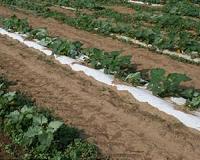 |
Davie FL (SPX) Jan 04, 2011 The nutrition and fertilization needs of container-grown ornamental plants during production are well-documented, but there is limited research about the plants' fertilizer requirements following transplantation into landscapes. A study from scientists at the University of Florida published in HortTechnology provides growers with new information and guidelines for post-transplant fertilization. Timothy K. Broschat and Kimberly Anne Moore reported on a study designed to determine if increasing the nitrogen content of fertilizers applied to transplanted container-grown areca palm and chinese hibiscus plants could accelerate the rate of establishment without exacerbating potassium and and/or magnesium deficiencies. Explaining the impetus for the research, Broschat noted that because landscape soils differ greatly in physical and chemical properties from the substrates used in container production, the nutritional requirements are also quite different. "While landscape soils in many parts of the United States are sufficiently fertile that routine fertilization of established woody ornamental plants is not required, in other areas, such as the highly leached sandy soils of the southern Atlantic coastal plain, nutrient deficiencies are common." Broschat and Moore transplanted container-grown areca palm (Dypsis lutescens) and chinese hibiscus (Hibiscus rosa-sinensis 'President') into a landscape soil and performed experiments using different fertilizer treatments. According to the researchers, although plants of both species had the darkest green color and largest size when continuously fertilized with high-nitrogen fertilizer, this treatment induced magnesium deficiency in both species. Plant size and color for both species were highly correlated with cumulative nitrogen application rates, but also with initial nitrogen application rates, suggesting that high-nitrogen fertilization during the first 6 months affected plant quality at 12 and 24 months after planting, even if high-nitrogen fertilization was discontinued. "Continued use of a moderate nitrogen landscape palm maintenance fertilizer ultimately produced areca palm plants as good as those receiving high nitrogen during the establishment period", added Broschat. Chinese hibiscus appeared to grow best with a sustained medium to high rate of nitrogen regardless of the analysis, but only when high-nitrogen fertilizer was used for 24 months did the treatment result in an increase in severity of magnesium deficiency symptoms in one of the experiments. Fertilization with high-nitrogen fertilizer for the first 12 months, followed by 12 months of moderate nitrogen landscape palm maintenance fertilizer resulted in the best overall quality in both experiments.
Share This Article With Planet Earth
Related Links University of Florida Farming Today - Suppliers and Technology
 Paper Mulches Evaluated For Commercial Vegetable Production
Paper Mulches Evaluated For Commercial Vegetable ProductionLexington KY (SPX) Jan 04, 2011 Polyethylene mulches, used widely in commercial vegetable production to improve crop yields and produce quality, have distinct disadvantages. Disposal options are limited, and plastic mulches often end up in landfills, being burned, or disposed of illegally. Recycling polyethylene mulches is also a challenge; the mulches used in large-scale vegetable production are contaminated with too mu ... read more |
|
| The content herein, unless otherwise known to be public domain, are Copyright 1995-2010 - SpaceDaily. AFP and UPI Wire Stories are copyright Agence France-Presse and United Press International. ESA Portal Reports are copyright European Space Agency. All NASA sourced material is public domain. Additional copyrights may apply in whole or part to other bona fide parties. Advertising does not imply endorsement,agreement or approval of any opinions, statements or information provided by SpaceDaily on any Web page published or hosted by SpaceDaily. Privacy Statement |